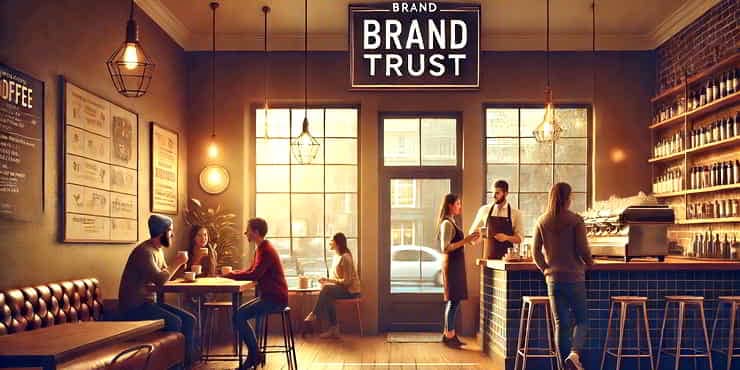Building Your Brand: Steps to Stand Out

Estimated reading time: 6 Min
Create a brand that sticks. Learn how to define your style, voice, and values—so you’re remembered, authentic, and trusted.
Without it, all the clever marketing, sleek design, and catchy taglines in the world won’t save you.
Imagine a favourite local café you keep returning to—what draws you back time and again?
It’s probably not just the coffee, but the consistency and the feeling that you know what to expect.
Trust forms the emotional glue that keeps customers loyal.
Do your customers trust you enough to choose you over someone else?
Let’s explore building that trust factor for your brand.
Understanding Trust in Branding
Trust in branding isn’t just about liking a product; it’s about confidence.
Customers want to feel that you will deliver on your promises—every time.
When you think of a trusted brand, like Apple or John Lewis, it’s not just about what they sell.
It’s about a reputation built over years of keeping promises and being consistent.
The difference between brand recognition and brand trust is vital.
People might know your name, but do they believe you’ll do what you say?
Brand trust is what turns awareness into loyalty.
Without trust, you’re just another name in a crowded market.
Why Trust Matters
Trust is certainly a feel-good factor but it’s also a business asset.
It affects customer loyalty, repeat purchases, and word-of-mouth recommendations.
A trusted brand becomes a recommendation that people feel confident sharing with friends.
Imagine trying to build a brand without trust.
It’d be like constructing a sandcastle on a windy day—impressive at first, but gone before you know it
.Define Your Brand Identity
To build trust, you need to define and communicate what your brand stands for.
A clear mission and set of values are essential.
Why do you exist beyond just making money?
What change are you bringing to your customers or the community?
Your mission statement should answer these questions simply and directly.
Think of this as the foundation.
Ask yourself questions like: “What would I want customers to say about us after their experience?”
The more clarity you have, the easier it will be for customers to relate to you and trust what you’re doing.
Consistency is Key
Whether it’s your tone, message, or visual identity, mixed messages cause confusion.
If your brand feels one way on your website and completely different on social media, customers will struggle to connect.
People trust what they understand, and consistency makes your brand understandable and reliable.
Building a Relationship with Your Audience
People are naturally wary of anything that feels too slick or too perfect.
Trust comes from showing a bit of vulnerability and authenticity.
Transparency is key.
If things go wrong, own up to it.
Admitting mistakes, and showing how you’ll do better, can actually strengthen your brand in the eyes of your customers.
Share behind-the-scenes stories, discuss challenges, and be open about your business.
Customers are more likely to trust a brand that they feel is being real with them. Honesty builds credibility.
Engage in Meaningful Communication:
Trust isn’t a one-way street.
It’s built by listening as well as talking.
Engage with your audience—ask for their thoughts, reply to their comments, and show genuine interest in what they have to say.
It’s not just about broadcasting your message but having real conversations.
Responding to customer questions and comments, inviting feedback, and showing that you care about what they think, creates a relationship beyond the transactional.
People trust brands that make them feel heard.
Over-deliver on Promises
This might sound old-fashioned, but it works.
Make promises you know you can keep, then go above and beyond.
Whether it’s delivering a product earlier than expected or adding a thoughtful personal touch, these little things make a big difference.
Consider an example: If you promise delivery within five days but deliver in three, that’s a win.
Customers are delighted when their expectations are exceeded.
Trust grows when people see you consistently go the extra mile.
Set Realistic Expectations
One of the quickest ways to destroy trust is to make big promises and fail to deliver.
Stay honest about what you can achieve.
If you over inflate your capabilities, you might get short-term attention but lose long-term credibility.
Setting realistic expectations upfront helps customers know what they’re getting into.
It’s much better to manage expectations and deliver on them, rather than promising the moon and leaving people feeling disappointed.
Customer Experience as Trust-Building

Every interaction a customer has with your brand is an opportunity to influence them and build trust.
From the moment they visit your website to their experience with customer support, every touch point matters.
I call them “moments of truth.”
Make sure each interaction is smooth, helpful, and consistent with your brand values.
Map out the customer journey and look for opportunities to add value.
This could mean offering helpful resources, providing prompt assistance, or simply making processes as easy as possible.
When customers feel valued and respected, trust naturally grows.
Social Proof and Testimonials:
People trust other people’s experiences.
Reviews, testimonials, and case studies are powerful tools for building credibility.
Showcasing what real customers say about your brand helps new customers feel more secure in their decision.
Encourage satisfied customers to share their experiences, whether through testimonials on your website or reviews on social media.
A positive testimonial can do more for trust than any amount of marketing copy.
Trust Takes Time
Trust isn’t built overnight. It takes time, consistent action, and patience.
Show up consistently, deliver what you promise, and keep putting your customers first.
Over time, this steady approach will help solidify your reputation as a trustworthy brand.
It’s important to remember that setbacks happen.
What matters is how you handle them.
Consistently responding to challenges with honesty and a willingness to improve will gradually build a resilient trust.
Measure and Reflect:
How do you know if your trust-building efforts are working? Keep an eye on customer retention metrics, customer satisfaction surveys, and feedback.
If customers keep coming back and recommending you to others, you’re on the right path.
Set regular intervals to reflect on your brand’s trust levels.
Are you meeting customer expectations?
Are there areas where you could improve?
Use these insights to adjust and refine your approach, always aiming to foster deeper trust.
FAQs
Why is brand trust so important?
Customers are more likely to return, recommend, and forgive mistakes if they trust your brand.
How long does it take to build brand trust?
Trust-building is a long-term process; it can take months or even years, depending on consistency and customer interactions.
What are some common mistakes that damage brand trust?
Over-promising, poor customer service, inconsistent messaging, and failure to address issues honestly.
How can small businesses compete with larger brands in terms of trust?
By being authentic, providing a personalised experience, and being more responsive than bigger competitors.
Can social media help build brand trust?
Absolutely. Engaging honestly, responding quickly, and showcasing behind-the-scenes content can all build trust.
Summary: Building Your Brand
Trust is the pillar on which great brands are built. It’s the difference between a one-time customer and a lifelong advocate.
By understanding what trust means, defining your brand clearly, engaging authentically, delivering on promises, and focusing on customer experience, you can build a brand that people not only recognise but also believe in.
Take the first step today.
Reflect on one area where you can improve trust—whether it’s being more transparent, delivering more consistently, or engaging more deeply with your audience.
Trust takes time, but every small step you take brings you closer to the brand loyalty you’re aiming for.
If you have any questions, just ask!
😉
Richard


![Are Wealthy Affiliate Hubs Revolutionising Website & Content Development In [year]? A futuristic and sleek digital workspace designed for website management and content creation - Wealthy Affiliate Hubs](https://ml0yvzumdtic.i.optimole.com/cb:eCO1.1fa0d/w:740/h:370/q:mauto/f:best/https://solobusinessmind.com/wp-content/uploads/2024/12/A-futuristic-and-sleek-digital-workspace-designed-for-website-management-and-content-creation-Wealthy-Affiliate-Hubs740x370-O.jpg)



